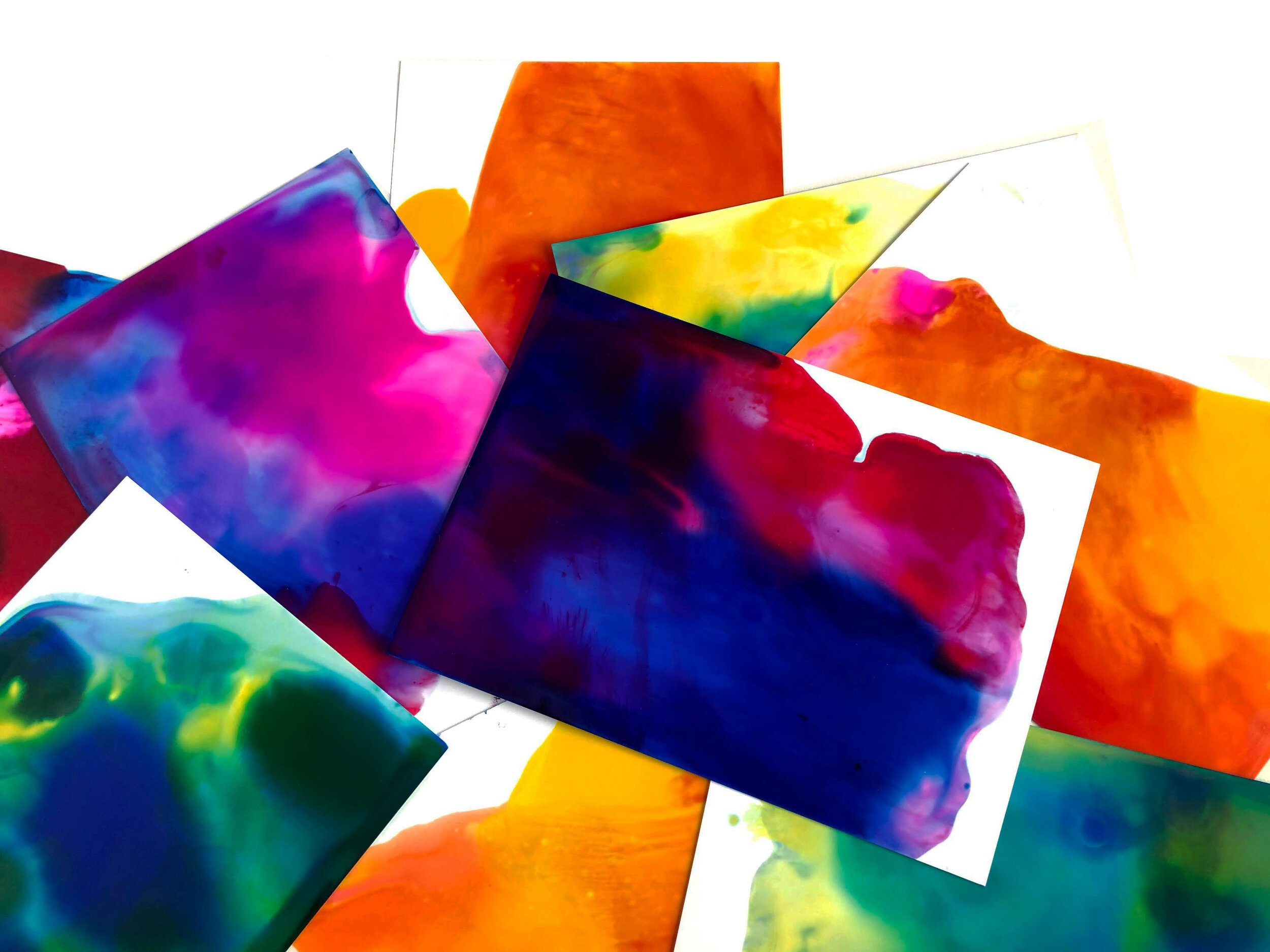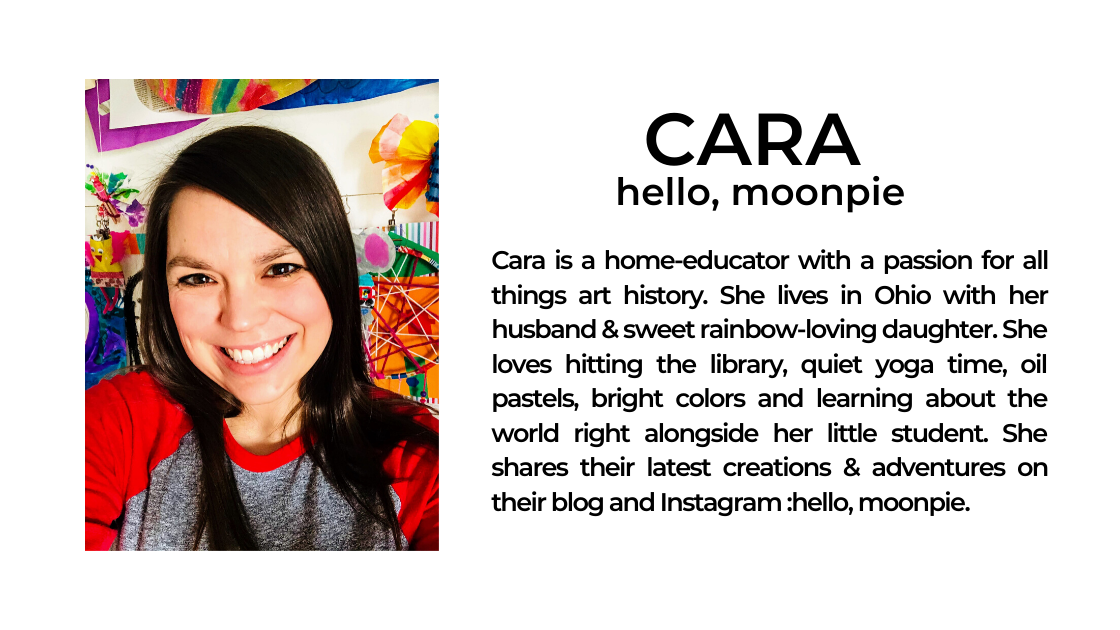Helen Frankenthaler inspired Puddle Paintings
There are no rules. That is how art is born, how breakthroughs happen. Go against the rules or ignore the rules. That is what invention is about.
- Helen Frankenthaler
Today I get to welcome two bold, color loving women whom I adore to the blog. Cara one half (of the art loving duo formerly known as Raising Kinley) of hello, moonpie and Helen Frankenthaler. If you are landing here from the Instagram kid art community you likely know Cara. She is the ambassador of cheerful good will and the CO of the welcome to the “neighborhood” committee. If you are the new kid on the IG block Cara is welcoming you with encouraging comments (usually doused with a playful pun) and a basket full of virtual warm chocolate chip cookies. Without getting too mushy or launching into an over share I will say that Cara’s brand of “sunshine in her pocket and good soul in her feet” is legit and it has been a tremendous source of comfort on many a not so happy day. Her “I think you need a snort laugh, so here ya go” timing is impeccable.
The other day we were having a re-branding pow wow and I said, “Cara, When I think of you I think: happy, colorful, fun, dedicated, inviting, encouraging, loving, warm. Cindy Lauper dance parties, together time, and creative adventures. We see you doing and that make us (mamas, caregivers, teacher types and artsy crafty peeps) feel like we can have that too.”
We all need some Vitamin C. Today’s post is drenched in C’s brand of the good stuff.. I will let Cara take it from here..
If you want to get lost in a sea of pretty just google Helen Frankenthaler (1928-2011). I know because I have spent hours (no exaggeration) doing just that over the past few weeks.
Throughout her long and prolific career, Helen dabbled in everything from printmaking to lithographs, clay and steel work to woodcutting, but she is best known as one of the original pioneers of the color-field style of abstract impressionism.
It was Helen’s “soak stain” technique that changed the game: she would thin her paint (first oil and later acrylic) to the consistency of watercolor. Then transfer the diluted paint to a coffee can with a hole cut out of the bottom. The thinned out paint would drain through the hole dumping puddles of color all over massive unprimed canvas that she lay across her studio floor. Helen would then move the puddles around her canvas using mops, sponges, squeegees or by lifting the corners and edges of the canvas.
“A really good picture looks as if it’s happened at once. It’s an immediate image. For my own work, when a picture looks labored and overworked, and you can read in it as well - she did this and then she did that; there is something in it that has not got to do with beautiful art to me. And I usually throw these out, though I think very often it takes ten of those over-labored efforts to produce one really beautiful wrist motion that is synchronized with your head and heart, and you have it, and therefore it looks as if it were born in a minute.”
It’s hard to choose a favorite Frankenthaler but I am really drawn to the paintings she created after taking a trip to Nova Scotia in 1963. They all feature bright, bold colors and sharper outlines than her earlier work and they are absolutely stunning. When I saw The Canal, Blue Atmosphere and The Bay I knew I wanted to play with her process on a smaller scale. We swapped canvas for one of our absolute favorite materials: photo paper!
Kinley and I had so much fun exploring Helen’s soak stain technique (we call them puddle paintings) that we couldn’t wait to share the process with you! We would love to see your puddle paintings! Tag @artcampla and @hello.moonpie on Instagram : )
Materials:
pipettes or eyedroppers
jar of water
paper towels
** Please note that we participate in the Amazon Affiliate program. This means if you purchase any of the products linked here we will receive a tiny sales commission at no additional cost to you. We only link to products we use and love. Your support helps us keep this site running - thank you!
The first thing you need to do is load up your muffin tin with the colors you want to use. Helen used her emotions and inspiration from the landscapes in her memories to choose her palette which might be fun to try, or you could try using some of the same color combos she used. Kinley and I decided to use our own signature palette — ALL of the colors! If you don’t want to end up with brown art, make sure to steer clear of any red + green, blue + orange, and purple + orange combinations ‘cause there is definitely going to be some blending going on. (We used the Blick brand liquid watercolors which are pretty thick and almost a gel consistency, so I added water to thin them out a little before we dove in. If yours are nice and squirtable straight out of the bottle, you can skip the extra water.)
1.Grab your art tray or cookie sheet and start dropping little dots of watercolor paint onto the surface with your pipettes. You want to drop the colors one at a time. You will use approximately 15-20 drops of color per puddle print. 2. Grab a clean pipette and squirt a little water on top of some of your colored dots. Feel free to experiment with this and find your process. Connect some of the dots with a stream of water to give them a head start on bleeding and blending. 3. When you feel like you have your color to water ratio where you want it grab a sheet of photo paper and squish it glossy side down into your paint puddle. You can let it soak for a few seconds or pick it right back up. If you want to give your “soak stains” some negative space like Helen did, make sure you hold up and edge or a corner when you do the puddle squish.
Flip your photo paper back over on your tray and take a look. Do you like how it looks or does it need a little something? If mine look a little too washed out for my liking, I use my pipettes to drop just a couple of dots of watercolor straight on the photo paper. Watching the color spread is mesmerizing! If it’s getting a little too saturated for your liking or you just want to experiment, use your pipette to squirt plain water on top of the dots and wash away some of the color.
We like to try and get three prints out of every puddle. Lift one print and perfect it. Add a couple more color dots and splashes of water then lift another and perfect that one, and then try the whole process one more time. If you still have pretty puddle left after that and don’t want to waste it, grab a notecard or some scratch paper to soak it up. Puddle prints always make lovely additions to stationary and collage-making collections.
Photo paper surprisingly doesn’t take very long to dry, usually an hour tops and that’s only if it’s really soaked.
Looking for a little extra information for little artists about the fun and splashy Helen Frankenthaler? There’s a really cute picture book you should check the library for called Dancing Through Fields of Color by Elizabeth Brown. It’s all about her life and style and we loved it!















